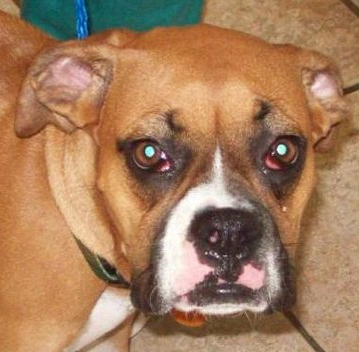William James, a 19th century psychologist described his anxiety in this way:
“A horrible dread at the pit of my stomach….a sense of the insecurity of life.”
We cannot know for sure if dogs experience dread but anyone walking into a vet clinic with a dog who would rather not be there has surely seen what could be described as a dog anticipating something unpleasant, dreading what is to come.
A dog who cowers and resists being put on leash may not be concerned about the leash itself, but what the leash predicts- exposure to things or situations the dog is afraid of. When people ask my fearful dog Sunny’s name I may tell them, but ask them not to use it. I have also told people his name is ‘Bosco’. For a people-fearful dog being spoken to predicts a social interaction with which the dog is not comfortable. When a dog hears their name they may begin to ‘dread’ what is going to happen next. In my dog’s case, ‘Bosco’ means nothing to him and if I suspect someone is not going to be able to follow my instructions regarding not talking to him, if they use Bosco, he is less likely to have a negative response on hearing it. It means nothing to him.
In order to help a dog learn to cope with and even feel good about something we have to address their fear and concern early on, when the dread begins, and then take a step back. Our ability to feel comfortable and confident improves as we learn to become proficient at a task or skill. A child won’t learn to swim if they are afraid to put their feet in the water. So we start by helping them to learn to do that. As they become proficient at entering the water we can slowly add to and increase the skills they need in order to swim. A dog who learns to put one foot on a step or take 2 steps up an a-frame may cease to dread approaching stairs or the agility obstacle. We allow the dog to practice just this simple behavior, moving away and returning to practice it again.
The challenge for most of us and our dogs is our sense of urgency for completing a behavior. We adopt a dog afraid of moving through hallways and because we live in an apartment building expect that the dog is going to learn to be comfortable immediately. We need them to be in order to take them outside. We bring home a puppy who has never been left on their own and plop them in a crate for hours at a time and expect they will quickly discover the joys of solitude because we have to go to work on Monday morning. We would not be foolish enough to assume that just because we’re going on holiday to the beach in two weeks that a non-swimmer is going to learn to become proficient enough at swimming so they’ll be comfortable and safe in the waves, just because WE need them to be.
When dealing with fears and anxiety follow the chain of experiences back and start by addressing the dread. We can’t force skills on a dog, but we can help them to want to learn them.






